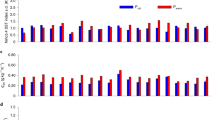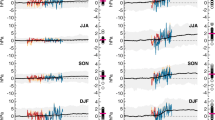Abstract
One may infer from the poleward propagation of angular momentum that energy change in tropical regions may be manifested in polar regions through a poleward propagation. This idea does not seem to be extensively addressed in the literature. It has been found that the poleward propagation of total atmospheric energy appears to connect the tropics and the polar regions on the interannual timescale. The present study explores how this poleward propagation may be linked to prominent climate oscillations such as ENSO, PNA, NAO, AO, AAO, and PSA. Analysis suggests that the poleward propagation of energy is likely a result of the atmospheric circulation change modulated by the climate patterns of ENSO, PNA, NAO, AO from tropical to Arctic regions and by the climate patterns of ENSO, PSA, AAO from tropical to Antarctic regions. The existence of the poleward energy propagation may shed light on studies exploring the linkage between topical climate and polar climate.





Similar content being viewed by others
Notes
NINO3.4 is the area-averaged sea surface temperature in the region bounded by 5°N–5°S, from 170°W to 120°W.
Similar characteristics of the stationary ΔFSFC, ΔFTOA, as well as the propagating behavior in their differences, also appear from the analysis using the data of ISCCP-FD (International Satellite Cloud Climatology Project; Rossow and Zhang 1995) (not shown).
References
Adams JM, Bond NA, Overland JE (2000) Regional variability of the Arctic heat budget in fall and winter. J Climate 13:3500–3510
Barnston G, Livezey RE (1987) Classification, seasonality and low-frequency atmospheric circulation patterns. Mon Weather Rev 115:1083–1126
Boer GJ, Sargent NE (1985) Vertically integrated budgets of mass and energy for the globe. J Atmos Sci 42:1592–1613
Carleton AM (1988) Meridional transport of eddy sensible heat in winters marked by extremes of the North Atlantic Oscillation, 1948/49–1979/80. J Climate 1:212–223
Chen T-C, Tribbia JJ, Yen M-C (1996) Interannual variation of global atmospheric angular momentum. J Atmos Sci 53:2852–2857
Christoph M, Barnett TP, Roeckner E (1998) The antarctic circumpolar wave in a coupled ocean–atmosphere GCM. J Climate 11:1659–1672
Derome J, Lin H, Brunet G (2005) Seasonal forecasting with a simple general circulation model: predictive skill in the AO and PNA. J Climate 18:597–609
Dickey JO, Marcus SL, Hide R (1992) Global propagation of interannual fluctuations in atmospheric angular momentum. Nature 357:484–488
Dickey JO, Gegout P, Marcus SL (1999) Earth–atmosphere angular momentum exchange and ENSO: the rotational signature of the 1997–1998 event. J Geophys Res 26:2477–2480
Dickey JO, Marcus SL, De Viron O (2003) Coherant interannual and decadal variations in the atmosphere-ocean system. Geophys Res Lett 30:1573. doi:10.1029/2002GL016763
Ghil M, Mo KC (1991) Intraseasonal oscillations in the global atmosphere. Part II: Southern Hemisphere. J Atmos Sci 48:780–790
Hall A, Visbeck M (2002) Synchronous variability in the Southern Hemisphere atmosphere, sea ice, and ocean resulting from the annular mode. J Climate 15:3043–3057
Held IM (2001) The partitioning of the poleward energy transport between the tropical ocean and atmosphere. J Atmos Sci 58:943–948
Jia X, Lin H, Derome J (2009) The influence of tropical Pacific forcing on the Arctic Oscillation. Clim Dyn 32:495–509
Jin F, Hoskins BJ (1995) The direct response to tropical heating in a baroclinic atmosphere. J Atmos Sci 52:307–319
Kang I-S, Lau KM (1994) Principal modes of atmospheric circulation anomalies associated with global angular momentum fluctuations. J Atmos Sci 51:1194–1205
Kidson JW (1988) Interannual variations in the southern hemisphere circulation. J Climate 1:1177–1198
Kushnir Y, Wallace JM (1989) Low frequency variability in the Northern Hemisphere winter: geographical distribution, structure and time-scale dependence. J Atmos Sci 46:3122–3142
Li S, Hoerling MP, Peng S, Weickmann KM (2006) The annular response to tropical Pacific SST forcing. J Climate 19:1802–1819
Lin H, Derome J, Greatbatch RJ, Peterson KA, Lu J (2002) Tropical links of the Arctic Oscillation. Geophys Res Letts 29(20). doi:10.1029/2002GL015822
Manney GL, Sabutis JL, Allen DR, Lahoz WA, Scaife AA, Randall CE, Pawson S, Naujokat B, Swinbank R (2005) Simulations of dynamics and transport during the September 2002 Antarctic major warming. J Atmos Sci 62:690–707
Marshall GJ (2003) Trends in the southern annular mode from observations and reanalyses. J Climate 16:4134–4143
Mo KC, White GH (1985) Teleconnections in the Southern Hemisphere. Mon Weather Rev 113:22–37
Mo KC, Dickey JO, Marcus SL (1997) Interannual fluctuations in atmospheric angular momentum simulated by the national centers for environmental prediction medium range forecast model. J Geophys Res 102:6703–6713
Moore RW, Haar THV (2001) Interannual variability of cloud forcing, meridional energy transport for the Northern Hemisphere winter from 1984 to 1990. J Climate 14:3643–3654
Nakamura N, Oort AH (1988) Atmospheric heat budgets of the polar regions. J Geophys Res 93(D8):9510–9524
Oort AH, Yienger JJ (1996) Observed interannual variability in the Hadley circulation and its connection to ENSO. J Climate 9:2751–2767
Peixoto JP, Oort AH (1992) Physics of climate. American Institute of Physics, New York, p 520
Rogers JC, Raphael MN (1992) Meridional eddy sensible heat fluxes in the extremes of the Pacific/North American tele-connection patterns. J Climate 5:127–139
Rossow WB, Zhang Y-C (1995) Calculation of surface and top of atmosphere radiative fluxes from physical quantities based on ISCCP data sets: 2. Validation and first results. J Geophys Res 100:1167–1197
Semmler T, Jacob D, Schlünzen KH, Podzun R (2005) The water and energy budget of the arctic atmosphere. J Climate 18:2515–2530
Sobolowski S, Frei A (2007) Lagged relationships between North American snow mass and atmospheric teleconnection indices. Int J Climatol 27:221–231. doi:10.1002/joc.1395
Tang Y, Lin H, Derome J, Tippett MK (2007) A predictability measure applied to seasonal predictions of the Arctic Oscillation. J Climate 20:4733–4750
Thompson DWJ, Solomon S (2002) Interpretation of recent Southern Hemisphere climate change. Science 296:895–899
Thompson DWJ, Wallace JM (1998) The Arctic Oscillation signature in the wintertime geopotential height and temperature fields. Geophys Res Lett 25(9):1297–1300
Thompson DWJ, Wallace JM (2000) Annular modes in the extratropical circulation. Part I: month-to-month variability. J Climate 13:1000–1016
Uppala SM, Kållberg PW, Simmons AJ, Andrae U, da Costa Bechtold V, Fiorino M, Gibson JK, Haseler J, Hernandez A, Kelly GA, Li X, Onogi K, Saarinen S, Sokka N, Allan RP, Andersson E, Arpe K, Balmaseda MA, Beljaars ACM, van de Berg L, Bidlot J, Bormann N, Caires S, Chevallier F, Dethof A, Dragosavac M, Fisher M, Fuentes M, Hagemann S, Hólm E, Hoskins BJ, Isaksen L, Janssen PAEM, Jenne R, McNally AP, Mahfouf J-F, Morcrette J–J, Rayner NA, Saunders RW, Simon P, Sterl A, Trenberth KE, Untch A, Vasiljevic D, Viterbo P, Woollen J (2005) The ERA-40 re-analysis. Quart J R Meteorol Soc 131:2961–3012
Wallace JM, Gutzler DS (1981) Teleconnections in the geopotential height field during the Northern Hemisphere winter. Mon Weather Rev 109:784–812
Webster PJ (1983) The large-scale structure of the tropical atmosphere. In: Hoskins BJ, Pearce R (eds) Large-scale dynamical processes in the atmosphere. Academic Press, New York, pp 235–276
Webster PJ, Chang H-R (1988) Equatorial energy accumulation and emanation regions: impacts of a zonally varying basic state. J Atmos Sci 45:803–829
Acknowledgments
We thank anonymous reviewers for their comments and suggestions which greatly improved the manuscript. This research was partially supported by the Cheney Research Foundation. SYW was supported by the Utah Agricultural Experiment Station, Utah State University.
Author information
Authors and Affiliations
Corresponding author
Rights and permissions
About this article
Cite this article
Huang, WR., Chen, TC. & Wang, SY. Co-variability of poleward propagating atmospheric energy with tropical and higher-latitude climate oscillations. Clim Dyn 39, 1905–1912 (2012). https://doi.org/10.1007/s00382-011-1238-3
Received:
Accepted:
Published:
Issue Date:
DOI: https://doi.org/10.1007/s00382-011-1238-3




